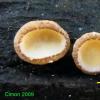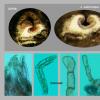
08-01-2026 21:22
 Blasco Rafael
Blasco Rafael
Hola, He recogido esta muestra de Orbilia sobre Re

07-01-2026 10:24
 Danny Newman
Danny Newman
Pezicula sp. on indet. hardwood Appalachian Highl

07-01-2026 22:22
 Danny Newman
Danny Newman
Tatraea sp. on indet. hardwood The Swag, Great Sm

07-01-2026 17:29
 Marc Detollenaere
Marc Detollenaere
Dear Forum,On a barkless Populus I found some smal

10-11-2021 17:33
 Riet van Oosten
Riet van Oosten
Add-on topic http://www.ascofrance.com/forum/7059

07-01-2026 10:05
 Danny Newman
Danny Newman
cf. Chaetospermum on XylariaCosby Campground, Grea

02-01-2026 17:43
MARICEL PATINOHi there, although I couldn't see the fruitbody, I

04-01-2026 17:45
 Stephen Martin Mifsud
Stephen Martin Mifsud
I was happy to find these orange asmocyetes which
50196 - Wilcoxina sp. probable
Roland Labbé,
31-03-2010 03:38
Voici un disco, probablement un Wilcoxina, mais sans poils disticts à la marge.
Merci de nous aide !
Amitiés !
Roland
Détails :
Date de récolte : 04 / 07 / 2009
Habitat : forêt mixte
Substrat : débris ligneux de feuillu
Spores largement ellipsoïdes, lisses, avec une grosse bulle de Barry très réfringente et parfois aussi petites, disparaissant après expulsion de l'asque, hyalines-jaunâtres, 11-13 x 7-8 µm, 11,5 x 7,25 µm en moyenne (8 spores), Q = 1,59
Asques à 8 spores unisériées, serrées dans l'asque vers l'apex et avec un peu d'espace libre à la base, avec appareil apical inamyloïde et sans crochet, 95-150 x 8-10 µm
Paraphyses cylindriques, parfois légèrement élargies à l'apex, à contenu huileux très fin à 100%, finement incrustées, 90-150 x 1 µm, ne dépassant pas les asques ou très peu
Excipulum en texture globulosa-angularis, formé de cellules globuleuses à ± ellipsoïdes, à paroi épaisse, ocre brunâtre
Poils excipulaires présents de la marge à la base, en faisceaux, arrivant de chaînes de cellules
Poils marginaux cylindriques à légèrement clavés, septés, à paroi épaisse, semblant comme enrobés dans une substance gélatineuse brunâtre
Poils de l'excipulum cylindriques effilés, à bulbe globuleux ± étiré, septées à la base, à paroi épaisse, brun ocre à brun foncé, 170-190 x 3-10 µm
Richard Korf,
31-03-2010 05:06
Re:50196 - Trichophaea sp. probable
The refringent guttules are not guttules, but DeBary bubbles. Tricharina?
Dick
Dick
Roland Labbé,
31-03-2010 05:15
Re:50196 - Trichophaea sp. probable
Thank you Richard !
The text is now corrected.
Is it OK ?
Roland
The text is now corrected.
Is it OK ?
Roland
Beñat Jeannerot,
31-03-2010 06:27
Hans-Otto Baral,
31-03-2010 16:01

Re:50196 - Trichophaea sp. probable
Dear Benat (& Roland)
since Roland supplied us only dead spores it is impossible to see the oil guttules, in my opinion. I think that what you named "G" is the detached protoplasm.
Tricharina has usually only a few small LBs near each end. The material appears to have been examined some months after drying, nevertheless I still wonder why the spores are no more alive. When there are actually no living spores, I recommend to mount in KOH, then the oil drops shoudl become visible.
Zotto
since Roland supplied us only dead spores it is impossible to see the oil guttules, in my opinion. I think that what you named "G" is the detached protoplasm.
Tricharina has usually only a few small LBs near each end. The material appears to have been examined some months after drying, nevertheless I still wonder why the spores are no more alive. When there are actually no living spores, I recommend to mount in KOH, then the oil drops shoudl become visible.
Zotto
Richard Korf,
31-03-2010 16:56
Re:50196 - Trichophaea sp. probable
I also am confused as to whether there are oleaginous guttules in the ascospores. The hairs, too, are not clear enough in the photos to make any real decision. This surely could still be a Trichophaea species. I don't recognize the species from the apothecial photos.
Dick
Dick
Roland Labbé,
31-03-2010 17:40
Richard Korf,
31-03-2010 17:58
Re:50196 - Trichophaea sp. probable
Marginal hairs still resemble Tricharina rather than Trichophaea.. Another possibility is Pseudaleuria.
Dick
Dick
Hans-Otto Baral,
31-03-2010 18:18

Re:50196 - Trichophaea sp. probable
I think we readily know more about the genus when seeing the spores in KOH. As I recall Trichophaea has guttule patterns different from Tricharina. And of course the hairs are different.
Zotto
Zotto
Roland Labbé,
31-03-2010 18:26
Re:50196 - Trichophaea sp. probable
Please, could you add a key on species Tricharina and Pseudaleuria if they exist !
I woud like to pass our species with them.
Roland
I woud like to pass our species with them.
Roland
Richard Korf,
31-03-2010 21:30
Re:50196 - Trichophaea sp. probable
Th main monograph is: Yang, C. S. & R. P. Korf. 1985b. A monograph of the genus Tricharina and of a new, segregate genus, Wilcoxina (Pezizales). Mycotaxon 24: 467-531.
You can get that on CYBERLIBER (see home page of www.mycotaxon.com for a link to CYBERLIBER)
Tr. fibrillosa which we treated was removed by Moravec as the type species of Pseudaleuria.
Dick
You can get that on CYBERLIBER (see home page of www.mycotaxon.com for a link to CYBERLIBER)
Tr. fibrillosa which we treated was removed by Moravec as the type species of Pseudaleuria.
Dick
Roland Labbé,
31-03-2010 22:03
Re:50196 - Trichophaea sp. probable
Thank you Richard !
I will go further with this document.
Are there new species since this publication ?
Roland
I will go further with this document.
Are there new species since this publication ?
Roland
Richard Korf,
31-03-2010 22:29
Re:50196 - Trichophaea sp. probable
Dear Roland,
Another peculiar feature of Tricharina is that the ascospores survive after drying (up to at least 20 years) and storage in the herbarium. Chain Yang was able to germinate ascospores of this genus (but not others we tried, like Trichophaea) and to obtain a mycelial anamorph resembling Rhizoctonia. W named the new genus for these Ascorhizoctonia, since true Rhizoctonia spp. all connect to Basidiomycetes. That reference is: Yang, C. S. & R. P. Korf. 1985. Ascorhizoctonia gen. nov. and Complexipes emend., two genera of anamorphs of species assigned to Tricharina (discomycetes). Mycotaxon 23: 457-48.
Those species of Tricharina which yield instead a Complexipes anamorphic state we treated in the new genus Wilcoxina,
Dick
Another peculiar feature of Tricharina is that the ascospores survive after drying (up to at least 20 years) and storage in the herbarium. Chain Yang was able to germinate ascospores of this genus (but not others we tried, like Trichophaea) and to obtain a mycelial anamorph resembling Rhizoctonia. W named the new genus for these Ascorhizoctonia, since true Rhizoctonia spp. all connect to Basidiomycetes. That reference is: Yang, C. S. & R. P. Korf. 1985. Ascorhizoctonia gen. nov. and Complexipes emend., two genera of anamorphs of species assigned to Tricharina (discomycetes). Mycotaxon 23: 457-48.
Those species of Tricharina which yield instead a Complexipes anamorphic state we treated in the new genus Wilcoxina,
Dick
Richard Korf,
31-03-2010 22:37
Re:50196 - Trichophaea sp. probable
Dear Roland,
I forgot to answer your query about more recent spp. These include:
Tricharina flava (Fuckel) J. Moravec (1990)
Wilcoxina sequoia (W. Phillips) T. Schumach. (1988)
Pseudaleuria quinaultiana Lusk (1987)
All can be checked in Index Fungorum
Dick
I forgot to answer your query about more recent spp. These include:
Tricharina flava (Fuckel) J. Moravec (1990)
Wilcoxina sequoia (W. Phillips) T. Schumach. (1988)
Pseudaleuria quinaultiana Lusk (1987)
All can be checked in Index Fungorum
Dick
Roland Labbé,
31-03-2010 22:42
Re:50196 - Trichophaea sp. probable
The new photo are dones : spores in KOH and marginal hairs.
They wil be set soon.
Thank's for information Richard.
Roland
They wil be set soon.
Thank's for information Richard.
Roland
Roland Labbé,
01-04-2010 05:56
Re:50196 - Trichophaea sp. probable
Hello !
The plate come just been modified :
- photo of the spores in KOH
- setting of marginal and expicular hairs
We hope this may help !
Roland
The plate come just been modified :
- photo of the spores in KOH
- setting of marginal and expicular hairs
We hope this may help !
Roland
Roland Labbé,
02-04-2010 04:14
Re:50196 - Wilcoxina sp. probable
Hi Hans and Dick !
Hairs are present on all the excipulum externe surface. This go for and Wilcoxina.
You can see changements in the texte and the palte.
Roland
Hairs are present on all the excipulum externe surface. This go for and Wilcoxina.
You can see changements in the texte and the palte.
Roland
Beñat Jeannerot,
02-04-2010 05:49

Re:50196 - Wilcoxina sp. probable
Hi Roland,
just an idea that I had not dared talked about when the proposed issue was Tricharina :
Wilcoxina mikolae (= Tricharina mikolae) has measures which correspond in range but substrate could not correspond...
See Mycologia 76(4) (1984) Yang & Wilcox p.675-684 and Mycotaxon 24 p.514 (1985), Yang & Korf
Both articles are on http://www.cybertruffle.org.uk/cyberliber/index.htm
Beñat
just an idea that I had not dared talked about when the proposed issue was Tricharina :
Wilcoxina mikolae (= Tricharina mikolae) has measures which correspond in range but substrate could not correspond...
See Mycologia 76(4) (1984) Yang & Wilcox p.675-684 and Mycotaxon 24 p.514 (1985), Yang & Korf
Both articles are on http://www.cybertruffle.org.uk/cyberliber/index.htm
Beñat
Richard Korf,
02-04-2010 14:56
Re:50196 - Wilcoxina sp. probable
Wilcoxina spp. seem always to be mycorrhizal with Pinaceae, but you do not say whether there were any conifers present at your collecting site. In neither Tricharina or Wilcoxina have I sen any records of species with ascosporess bearing DeBary bubbles. Spores of both genera seem to have a spumose content, often a bit yellowish. I am not sure what the hairs really look like in your material. The photos are at much too small a magnification. See the drawings of hairs in the Wang & Korf paper. This could still be a Trichophaea or a Pseudaleuria. I remain unconvinced on its generic placement.
Roland Labbé,
02-04-2010 19:35
Re:50196 - Wilcoxina sp. probable
Here are our last photos of hairs.
That's all we can do.
Wilcoxina alaskana is not mycorrhizal but grows on rotten wood, and we don't know its spores.
Dick, do you have a documentaiton on Pseudaleuria to send please ?
Merci de Québec, amitiés à vous tous !
Roland, Jacqueline et Jules.
That's all we can do.
Wilcoxina alaskana is not mycorrhizal but grows on rotten wood, and we don't know its spores.
Dick, do you have a documentaiton on Pseudaleuria to send please ?
Merci de Québec, amitiés à vous tous !
Roland, Jacqueline et Jules.
Richard Korf,
03-04-2010 03:37
Re:50196 - Wilcoxina sp. probable
I regret I have no more information on the genus than its original description for one west coast sp., Pseudaleuria quinaultiana Lusk, Mycotaxon 30: 419-ff. (1987), with quite different hairs. Though he draws many conclusions that suggest a relationship to the Sarcoscyphaceae, he nonetheless places it near Aleuria. He also mentions Tricharina fibrillosa as being close, but did nor transfer it to the genus, which Moravec did later: Acta Musei Moraviae, Sci. biolog. 88(1/2): 51 (2003). I have not studied Ps. quinaultiana which grows on wood and soil, and "may be" mycorrhizal according to Lusk.
Dick
Dick





